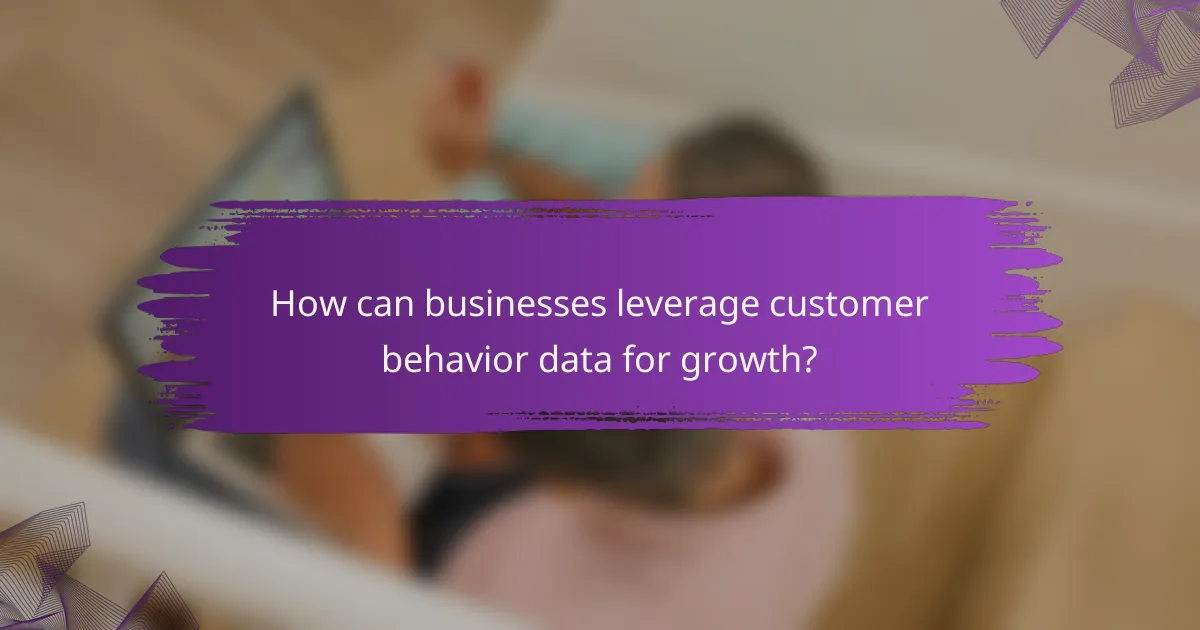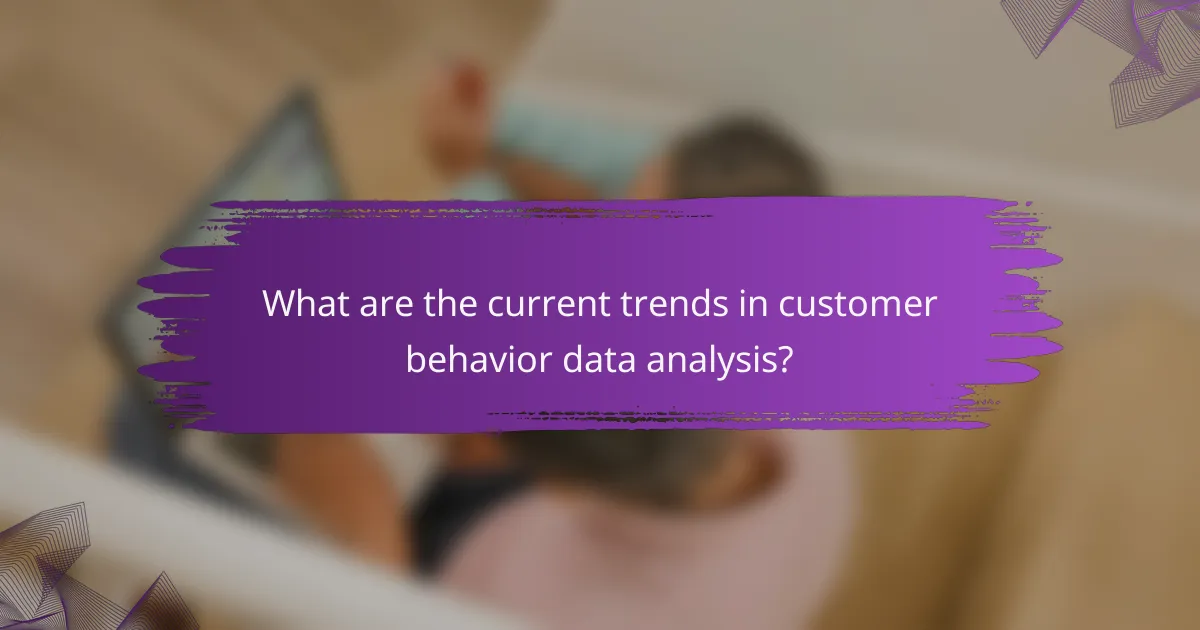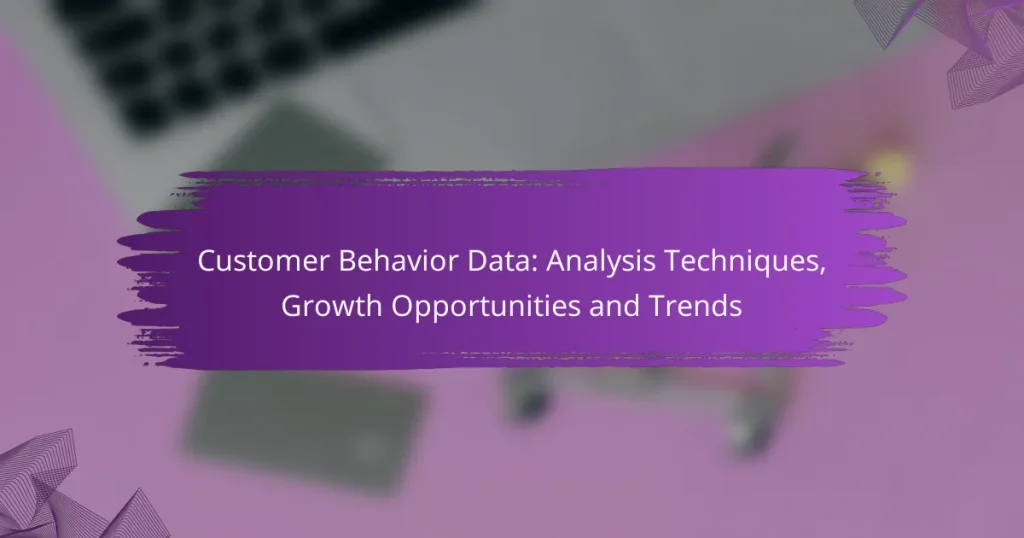Understanding customer behavior data is crucial for businesses seeking to enhance growth and customer satisfaction. By employing various analysis techniques such as descriptive and predictive analysis, companies can gain valuable insights into customer actions and preferences. This data not only helps in identifying trends but also aids in tailoring offerings to meet market demands effectively.

What are the key analysis techniques for customer behavior data?
Key analysis techniques for customer behavior data include descriptive, predictive, prescriptive, sentiment, and cluster analysis. Each technique offers unique insights that can help businesses understand and anticipate customer actions, ultimately driving growth and improving customer satisfaction.
Descriptive analytics
Descriptive analytics focuses on summarizing historical data to understand what has happened in the past. It involves the use of statistical measures such as mean, median, and mode to provide insights into customer behavior trends. For example, a retail company might analyze sales data to determine peak shopping times or popular product categories.
Common tools for descriptive analytics include dashboards and reporting software that visualize data trends. Businesses should ensure data accuracy and relevance to draw meaningful conclusions from their analyses.
Predictive analytics
Predictive analytics uses historical data and statistical algorithms to forecast future customer behavior. By identifying patterns and trends, businesses can anticipate customer needs and preferences. For instance, an e-commerce platform might use predictive models to recommend products based on past purchases.
To implement predictive analytics effectively, companies should invest in robust data collection methods and machine learning algorithms. Regularly updating models with new data is crucial for maintaining accuracy in predictions.
Prescriptive analytics
Prescriptive analytics goes a step further by recommending actions based on predictive insights. This technique helps businesses determine the best course of action to achieve desired outcomes, such as increasing sales or improving customer retention. For example, a subscription service might use prescriptive analytics to optimize pricing strategies based on customer behavior.
Implementing prescriptive analytics requires a combination of data analysis and business acumen. Companies should consider potential trade-offs and risks when following recommendations generated by these analyses.
Sentiment analysis
Sentiment analysis involves evaluating customer feedback, reviews, and social media interactions to gauge public opinion about a brand or product. This technique helps businesses understand customer emotions and attitudes, which can inform marketing strategies and product development. For instance, a restaurant chain might analyze customer reviews to identify areas for improvement.
To conduct effective sentiment analysis, companies can use natural language processing tools that categorize feedback as positive, negative, or neutral. Regular monitoring of sentiment can help businesses respond proactively to customer concerns.
Cluster analysis
Cluster analysis groups customers based on similar behaviors or characteristics, allowing businesses to identify distinct segments within their customer base. This technique can reveal insights into customer preferences and help tailor marketing efforts. For example, a clothing retailer might use cluster analysis to segment customers by shopping habits and target them with personalized promotions.
When performing cluster analysis, businesses should select appropriate algorithms and consider the number of clusters to create. It’s essential to validate the results to ensure meaningful segmentation that can drive effective marketing strategies.

How can businesses leverage customer behavior data for growth?
Businesses can leverage customer behavior data to identify trends, tailor offerings, and enhance customer experiences, ultimately driving growth. By analyzing this data, companies can make informed decisions that align with customer preferences and market demands.
Personalized marketing strategies
Personalized marketing strategies utilize customer behavior data to create targeted campaigns that resonate with individual preferences. By segmenting customers based on their past interactions, businesses can deliver tailored messages that improve engagement and conversion rates.
For example, an online retailer might analyze browsing history to recommend products that align with a customer’s interests, increasing the likelihood of purchase. Implementing A/B testing can further refine these strategies by identifying which messages perform best.
Product development insights
Customer behavior data provides valuable insights that can inform product development. By understanding what features or products customers frequently engage with, businesses can prioritize enhancements or new offerings that meet market demands.
For instance, a software company might track user interactions to identify underused features, prompting a redesign or removal. Regularly gathering feedback through surveys or focus groups can also ensure that product development aligns with customer needs.
Customer retention initiatives
Leveraging customer behavior data is crucial for developing effective customer retention initiatives. By analyzing churn patterns, businesses can identify at-risk customers and implement strategies to re-engage them.
For example, a subscription service might offer personalized discounts or targeted communications to users showing signs of disengagement. Regularly monitoring customer satisfaction through Net Promoter Scores (NPS) can help gauge the effectiveness of these initiatives.
Sales forecasting
Sales forecasting can be significantly enhanced by utilizing customer behavior data. By analyzing historical purchase patterns and trends, businesses can predict future sales with greater accuracy.
For instance, a retail store might analyze seasonal buying trends to optimize inventory levels and staffing during peak times. Employing predictive analytics tools can further refine these forecasts, helping businesses make proactive decisions that align with anticipated customer demand.

What are the current trends in customer behavior data analysis?
Current trends in customer behavior data analysis focus on leveraging advanced technologies and ethical considerations to enhance insights and decision-making. Businesses are increasingly adopting innovative techniques to process and interpret data, ensuring they remain competitive and responsive to consumer needs.
Increased use of AI and machine learning
The integration of AI and machine learning in customer behavior data analysis is transforming how businesses understand their customers. These technologies enable the processing of vast amounts of data to identify patterns and predict future behaviors, enhancing personalization and targeting strategies.
For example, retailers can use machine learning algorithms to analyze purchasing patterns and recommend products tailored to individual preferences, leading to increased sales and customer satisfaction. Companies should invest in training their teams to effectively utilize these technologies for maximum impact.
Real-time data processing
Real-time data processing allows businesses to analyze customer behavior as it happens, providing immediate insights that can inform marketing strategies and operational decisions. This trend is crucial for industries like e-commerce, where timely responses can significantly affect customer engagement and conversion rates.
Implementing real-time analytics tools can help businesses track customer interactions across platforms, enabling them to adjust campaigns on the fly. Companies should ensure they have the necessary infrastructure and expertise to support real-time data processing effectively.
Focus on privacy and data ethics
As data privacy concerns grow, businesses are increasingly prioritizing ethical data practices in customer behavior analysis. Compliance with regulations such as GDPR in Europe and CCPA in California is essential to maintain customer trust and avoid legal repercussions.
Organizations should adopt transparent data collection practices and ensure customers are informed about how their data will be used. Implementing robust data security measures and regularly reviewing privacy policies can help mitigate risks associated with data handling.
Integration of omnichannel data
Integrating omnichannel data is vital for gaining a comprehensive view of customer behavior across various touchpoints. This approach allows businesses to understand how customers interact with their brand, whether online or offline, leading to more effective marketing strategies.
To achieve successful integration, companies should invest in data management systems that consolidate information from different channels. This enables a seamless customer experience and helps identify trends that may not be visible when analyzing data from isolated sources.

What criteria should businesses consider when selecting analysis tools?
Businesses should consider several key criteria when selecting analysis tools, including scalability, integration capabilities, user-friendliness, and cost-effectiveness. These factors ensure that the chosen tools can meet current needs and adapt to future growth.
Scalability of the tool
Scalability refers to a tool’s ability to handle increasing amounts of data and users without compromising performance. Businesses should evaluate whether the tool can grow alongside their operations, particularly if they anticipate rapid expansion or fluctuating data volumes.
For instance, a small startup may initially require basic analytics, but as it scales, it may need advanced features like real-time data processing. Choosing a scalable tool can save costs and reduce the need for frequent replacements.
Integration capabilities
Integration capabilities determine how well an analysis tool can work with existing systems and software. A tool that easily integrates with Customer Relationship Management (CRM) systems, marketing platforms, and databases can streamline workflows and enhance data accuracy.
Businesses should look for tools that support common integration standards, such as APIs or data connectors. This compatibility can significantly reduce the time and resources needed for implementation.
User-friendliness
User-friendliness is crucial for ensuring that team members can effectively utilize the analysis tool. A tool with an intuitive interface and clear navigation can minimize training time and encourage widespread adoption across the organization.
Consider tools that offer customizable dashboards and visualizations, as these features can help users quickly interpret data insights. A user-friendly tool can lead to better decision-making and improved overall productivity.
Cost-effectiveness
Cost-effectiveness involves assessing whether the benefits of an analysis tool justify its price. Businesses should evaluate both upfront costs and ongoing expenses, such as subscription fees or maintenance costs, to ensure they align with their budget.
It’s advisable to compare different tools based on their features and pricing models. Some tools may offer tiered pricing based on usage, which can be beneficial for businesses with fluctuating needs. Always consider the return on investment when selecting a tool.


